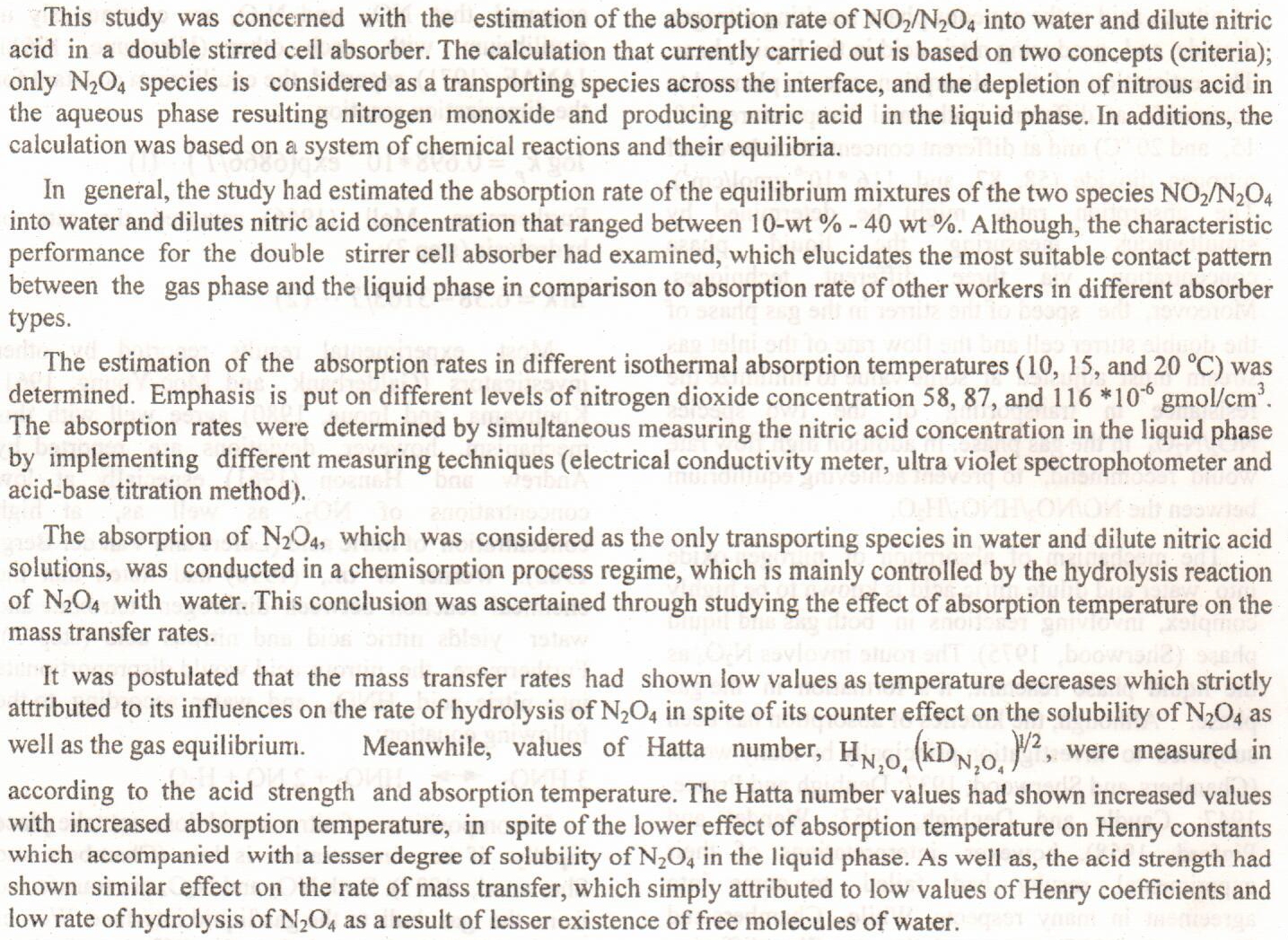
 (9)
(9)
 (8)
(8)
 (3)
(3)
 (2)
(2)
 (3)
(3)
 (2)
(2)
Galvanic corrosion of stainless steel 316 (SS316) and carbon steel (CS) coupled in 5% wt/v sulfuric acid solution at agitation velocity was investigated. The galvanic behavior of coupled metals was also studied using zero resistance ammeter (ZRA) method. The effects of agitation velocity, temperature, and time on galvanic corrosion current and loss in weight of both metals in both free corrosion and galvanic corrosion were investigated. The trends of open circuit potential (OCP) of each metal and galvanic potential (Eg) of the couple were, also, determined. Results showed that SS316 was cathodic relative to CS in galvanic couple and its OCP was much more positive than that of CS for all investigated ranges of
... Show MoreSpent catalysts for sulfuric acid production have large amount of vanadium and due to environmental authority it is required to reduce the vanadium contain of the spent catalyst. Experimental investigation was conducted to study the vanadium recovery from spent catalyst via leaching process using sodium hydroxide to study the effect of process variables (temperatures, sodium hydroxide molarities, leaching time and particle size) on vanadium recovery. The effect of process variables (temperature, particle size,molarities of sodium hydroxide and leaching time) on the percentages of vanadium recovery were investigated and discussed .It was found that the percentage of vanadium recovery increased with increasing temperature up to 100 , incre
... Show MoreThis paper presents the ability to use cheap adsorbent (corn leaf) for the removal of Malachite Green (MG) dye from its aqueous solution. A batch mode was used to study several factors, dye concentration (50-150) ppm, adsorbent dosage (0.5-2.5) g/L, contact time (1-4) day, pH (2-10), and temperature (30-60) The results indicated that the removal efficiency increases with the increase of adsorbent dosage and contact time, while inversely proportional to the increase in pH and temperature. An SEM device characterized the adsorbent corn leaves. The adsorption's resulting data were in agreement with Freundlich isotherm according to the regression analysis, and the kinetics data followed pseudo-first-or
... Show More (5)
(5)
The preparation of low cost activated carbon from date stones and microwave method by using K2CO3 as chemical activator were investigated.
The prepared activated carbon was used to remove fluoroquinolones antibiotics from aqueous solution. The characterizations of the activated carbon is represented by surface area, pore volume, ash content, moisture content, bulk density, and iodine number. The adsorbed fluoroquinolones antibiotics are Ciprofloxcin (CIP), Norfloxcin (NOR) and Levofloxcin (LEVO). Different variables as pH, initial concentrations and contact time were studied to show the efficieny of prepared activated carbon. The experimental adsorption data were analyzed by Lungmuir, Freundlich
... Show More
In this paper, the ability of using corn leaves as low-cost natural biowaste adsorbent material for the removal of Indigo Carmen (IC) dye was studied. Batch mode system was used to study several parameters such as, contact time (4 days), concentration of dye (10-50) ppm, adsorbent dosage (0.05-0.25) gram, pH (2-12) and temperature (30-60) oC. The corn leaf was characterized by Fourier-transform infrared spectroscopy device before and after the adsorption process of the IC dye and scanning electron microscope device was used to find the morphology of the adsorbent material. The experimental data was imputing with several isotherms where it fits with Freundlich (R2 = 0.9
... Show More (8)
(8)
 (6)
(6)
This studies deals with investigated the potential of a Iraqi bentonite clay for the adsorption of bromo phenol red dye from contaminated water. Impulse adsorption experiments were performed. The contact time influence of initial dye concentration, temperature, pH, ionic strength, partical size adsorbent and adsorbent dosage on bromo phenol red adsorption are investigated in a series of batch adsorption experiments. Adsorption equilibrium data were analyzed and described by the Freundlich, Langmuir and temkin isotherms equations. Thermodynamic parameters inclusive the Gibbs free energy (∆G• ), enthalpy (∆H• ), and entropy (∆S• ), were also calculated. These parameters specified that adsorption of bromo phenol red onto bentonite
... Show More